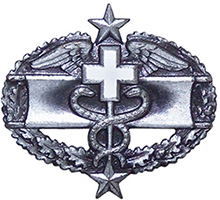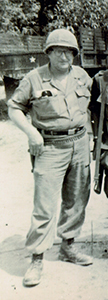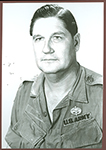
Combat Medical Badge (A Portrait of Courage)
Robert L. Ampula
Administrative Officer
U.S. Army Medical Department Regiment
The weather was already steamy early on the morning of July 31st 1943 in the jungles of New Georgia in the Solomon Islands. A heated battle had begun between the 161st Infantry Regiment and heavily defended Japanese soldiers who were positioned on a strategic hill above Munda Airfield. The Japanese had constructed well concealed machine guns and rifle emplacements covering all approaches to the hill making for a brutal confrontation. The attack was further hampered by fallen trees and underbrush which limited visibility to 30 yards.
 The battle raged throughout the day with the 161st Infantry Regiment slowly inching forward, pillbox to pillbox. It wasn’t until about 1700, however, that the leading element emerged through the smoke and haze of the engagement and neared the crest of the hill. Suddenly, two machine guns sprang to life and spewed fire on the unsuspecting and exposed Soldiers, killing one and severely injuring another. To make matters even worse, the injured Soldier lay in an exposed area only 25 yards from the menacing machine guns.
The battle raged throughout the day with the 161st Infantry Regiment slowly inching forward, pillbox to pillbox. It wasn’t until about 1700, however, that the leading element emerged through the smoke and haze of the engagement and neared the crest of the hill. Suddenly, two machine guns sprang to life and spewed fire on the unsuspecting and exposed Soldiers, killing one and severely injuring another. To make matters even worse, the injured Soldier lay in an exposed area only 25 yards from the menacing machine guns.
Upon learning of the injured man, Technician Fifth Grade Henry Jenkins quickly volunteered to attempt a rescue. After a hastily formulated plan, Jenkins crawled forward with two other Soldiers to a large tree approximately 15 yards from the fallen Soldier. On a pre-arranged signal, friendly machine guns focused fire on the Japanese positions. At that same moment, Jenkins leaped to his feet and ran to within 25 yards of the Japanese positions. With the help of the two other Soldiers, they retrieved the wounded Soldier, returned back across the open terrain and moved him to a place of relative safety. Henry then started treating his wounds. He would remain with the Soldier throughout the night until he could be safely evacuated the following morning.
Almost two years later, another Army medic was again engaged with the Japanese Army, this time on Mindanao during the liberation of the Philippines. The Japanese had well constructed defensive positions and their Soldiers were well conditioned, making for a difficult campaign. Private First Class Wayne Slagel1 waded ashore with the rest of the 124th Infantry Regiment, 31st Infantry Division on 22 April 1945 lugging his oversized aid bag along with his other equipment. He had learned that supplies in battle soon run out and had improvised an engineer’s demolition bag to serve as his medical aid bag. It would prove to be a fortunate thing for members of his unit.
As if the Japanese were not formidable enough, the weather and terrain played havoc with offensive maneuvers during the operation. The incessant rain had turned the terrain into a quagmire of mud, oftentimes knee deep. Where there was vegetation, it was thick and one had to fight to get through it. In addition, the tangle of trees and plants limited visibility and eliminated the possibility of approaching the enemy stealthily, making a dangerous mission even more so. The progress was physically exhausting as well, and the heat withering, but the soldiers advanced steadily, albeit slowly.
 On 1 May 1945, Slagel’s rifle platoon ran into stiff resistance from the enemy. Mortar rounds rained down on their positions and concealed machine gun emplacements started a blistering fire. In the chaos that followed, several Soldiers were severely wounded. With complete disregard for his own safety, PFC Slagel voluntarily moved forward under this heavy machine gun and mortar fire to administer aid to the wounded men and moved them to safety. Again and again he moved about exposed to the heavy concentration of fire and his actions undoubtedly saved many lives.
On 1 May 1945, Slagel’s rifle platoon ran into stiff resistance from the enemy. Mortar rounds rained down on their positions and concealed machine gun emplacements started a blistering fire. In the chaos that followed, several Soldiers were severely wounded. With complete disregard for his own safety, PFC Slagel voluntarily moved forward under this heavy machine gun and mortar fire to administer aid to the wounded men and moved them to safety. Again and again he moved about exposed to the heavy concentration of fire and his actions undoubtedly saved many lives.
For their actions, Technician Fifth Grade Henry Jenkins earned the Silver Star2 and PFC Wayne Slagel would earn the Bronze Star for valor. Both Soldiers would receive the newly authorized Combat Medical Badge3.
The Combat Medical Badge (CMB) turned 68 years old on March 1st 2013 and it seems an appropriate time to recognize the only known and documented triple recipients of the badge. Although we have found reference to five individuals who may have received the badge three times, we have never been able to document the others.
The Combat Medical Badge was originally established as a companion badge to the Combat Infantryman Badge (CIB). Early in the war it was duly noted that the infantry was subjected to the worst conditions in combat, sustained the most casualties and received very little, if any, recognition for their sacrifice and heroic actions. The infantry operated under the most extreme conditions and were the only soldiers whose daily mission was to close with and destroy the enemy and seize and hold terrain. As such, the decision was made to create the CIB and award additional pay of $10 a month to those infantrymen who qualified4. The CIB was established by the War Department on 27 October 1943 and was retroactive to 7 December 1941.
While the infantrymen were recognized with the CIB and garnered the additional $10 a month in pay, it was quickly noted by the Soldiers and their leaders that the medics assigned to those same units were not included in the award of the CIB even though they suffered on a daily basis the same hardships, dangers, and casualty rates as their infantry counterparts. The issue was continuously raised, but it would take a year and a half to rectify this omission. The Soldiers of some infantry units took the matter into their own hands and took up collections among themselves and paid additional allowances out of their own pockets to their medical corps “buddies”5. After learning of this, several American newspapers wrote editorials in support of these generous infantrymen and tried to spark interest in military authorities to change the combat pay regulation. On March 1, 1945 the Medical Badge was finally authorized by the War Department with the additional pay of $10 a month. This award, too, was retroactive to 7 December 1941.
In 1950 Henry Jenkins was assigned to the 17th Infantry Regiment, 7th Infantry Division. Henry joined them as they were deploying to Korea and came ashore as part of the Inchon landings. Now a Sergeant, Jenkins described the casualties as surprisingly light during the liberation of Seoul until an accidental friendly fire incident6. The Division then participated in a second amphibious landing at Iwon in North Korea and pushed toward the border with Manchuria on 29 October 1950. The fighting proved to be tougher at Iwon and daily confrontations occurred. The weather also became a factor with the bitter cold inflicting almost as many casualties as the enemy.
On 2 November 1950 near Pungwan, Korea, a heated battle was in progress. The first platoon was subjected to heavy small arms and mortar fire which resulted in many casualties. With utter disregard for his own personal safety, Sergeant Jenkins exposed himself repeatedly to enemy fire as he moved about the platoon administering to the wounded. A bullet went through his leg in the early stages of the attack, but he continued to give first aid to the wounded and assisted in their evacuation.
In the bloody fighting that followed, Sergeant Jenkins' courage and supreme devotion to duty was displayed time after time, as he refused to be evacuated in spite of his painful wound and continued to administer to the wounded, not only of his platoon, but of those in the second platoon as well. Seven hours after he was wounded, his condition was brought to the attention of the Company Commander. Sergeant Jenkins was found to be seriously wounded and suffering from loss of blood. Only after he was so ordered would he allow himself to be evacuated to the battalion aid station where he was further evacuated to the rear7.
Wayne Slagel was assigned to the 27th Infantry Regiment (Wolfhounds), 25th Infantry Division in Korea. He joined them on Heartbreak Ridge. At this point, the Korean War had entered the stalemate phase. The fighting had resorted to warfare similar to that of World War I’s trenches. Each side would periodically send rockets and mortar fire at the other which caused many deaths and injuries, but little ground was gained by either side. Once again, the cold weather caused many incidents of frost bite and there were a surprising number of asphyxiations. The Koreans brought up charcoal for heat in the extreme cold. Soldiers on the line would take the charcoal to their position in a container and cover themselves with a blanket, not allowing space for the fumes to escape and fresh air to enter. Despite warnings, many of these Soldiers were found dead the next morning.
One particularly frigid morning mortars fired by the Koreans and their Chinese counterparts started pounding the Wolfhounds. The cry for medic could be heard up and down the line as havoc prevailed. With his oversized medical aid bag, SGT Slagel started treating his wounded comrades as the punishing rounds exploded all around him. He would move from casualty to casualty with complete disregard for his own safety. Slagel later stated that this day was not much different than many others during his time in Korea.
SGT Slagel would also accompany 5 to 7 man patrols beyond the front lines. These were predominantly night patrols and they ventured out into the expanse between forces. Many of these patrols turned into vicious firefights with the enemy, and on many occasions Slagel’s squad mates were wounded. Without thought for his own safety, SGT Slagel ventured out to the wounded Soldiers, brought them back to positions of relative safety and treated their wounds. SGT Slagel would later say that these patrols were also routine.
For their actions in Korea, SGT Jenkins would receive his second Silver Star and SGT Slagel would earn his third Bronze Star. Both men would earn their second Combat Medical Badges for their roles in Korea.
At the end of World War II the Combat Medical Badge went into disuse. With the start of the Korean War, the badge was again authorized with a beginning date of 27 June 1950. Second awards of the Combat Medical Badge are indicated by superimposing a star centered at the top of the badge between the points of the oak wreath.
Late 1965 found Sergeant First Class Jenkins landing in Vietnam with the 28th Infantry Regiment, 1st Infantry Division. The unit moved to Phuoc Vinh, Vietnam and started carving out their future base camp. The regiment’s first major operation was Operation Crimp. Although there were no heavy engagements with the enemy, they did uncover a large tunnel and trench complex and destroyed large quantities of supplies. Before the next major operation, Henry Jenkins’s unit would take part in the Red Ball convoy operations bringing supplies from Saigon to their home base. These convoys were often the target of enemy attacks and were a dreaded duty for most of those involved.
During Operation Birmingham, Henry was reminded of his time on New Georgia as he found himself in dense jungle fighting a determined enemy who was entrenched amongst the thick foliage. This operation was a concentrated attack into the established enemy base camps in Tay Ninh Province. The unit destroyed all the base camps they uncovered and disrupted the supply system that was vital to the enemy’s operations in that area.
The 28th returned to their base camp in Phuoc Vinh after Operation Birmingham and take up counter insurgency warfare in that area. On more than one occasion, mortar fire crashed into the base camp destroying portions of the infrastructure, killing and wounding many. Henry rushed to treat all the wounded along with the other medics. Henry reported that these attacks were regular, but were not attempts to overrun the base, but instead to harass its occupants.
In Vietnam, SFC Slagel was assigned to his old unit, the Wolfhounds, and was the NCOIC of the 2nd Brigade dispensary. On 1 Feb 1968, mortar rounds started landing all over the camp. Then the rockets started. It was the first time Slagel had heard a rocket. He stated it sounded like a train coming in from the sky. In the chaos that ensued, the cry of “Medic!” was heard throughout the camp. The TET Offensive had begun in earnest. Luckily for many, SFC Slagel still had his oversized medical bag and he treated as many wounded as he could. He had been wounded in the hand, leg and knee by an exploding mortar shell, but continued treating the wounded ignoring his own wounds. His next thought was on the battalion aid station which he assumed would be overwhelmed and needed additional help. He made his way to the station and continued to treat the wounded. When he had provided all of the medical aid that he could, he allowed himself to be treated.
SFC Slagel accompanied MEDCAP teams treating the civilian populace as well. The MEDCAP teams ventured out into the villages, accompanied by the infantry, to treat the wounded populace and gather whatever information they could garner on the enemy. Slagel would go on more of these missions than he could count before his time was up in Vietnam.
The CMB was reintroduced on 2 March 1961 and both Slagel and Jenkins received their third award of the Combat Medical Badge for service in Vietnam. The third award of the CMB is indicated by superimposing a star centered at the bottom of the badge. Unlike WW II and the Korean War, the Vietnam War period continued beyond the end of the war and included service in Laos, the Dominican Republic, El Salvador, Grenada, Panama, Southwest Asia Conflict, Korea on the DMZ and Somalia. This period would officially end on 10 March 1995. Regardless of the number of conflicts one participated in, only one award of the Combat Medical Badge was authorized. The fourth, and current period for which the badge may be awarded began 5 December 2001. Once again, only one badge can be awarded during this period even if one has participated in both OIF and OEF or had multiple tours to the same conflict.
Sadly, Wayne Eugene Slagel died of cancer on 15 April 1998 and Henry Lavor Jenkins, “Doc” to his friends, passed away October 2, 2004. With them passed the only known triple recipients of the Combat Medical Badge. As we approach the two decade mark since the Vietnam era of awards ended, it is unlikely we will see another triple recipient of the Combat Medical Badge anytime in the near future. It is appropriate that we recognize the anniversary of the creation of the Combat Medical Badge. It is equally fitting that we should recognize the only two Soldiers we can document who, not only participated in three wars and earned the Combat Medical Badge three times, but epitomized the “To Conserve The Fighting Strength” motto that appears on the scroll of the Army Medical Department Regimental Flag.
Notes:
1Wayne Rupert Slagle was raised by his grandmother who did not know his middle name or the spelling of his last name. It wasn’t until 1967 when Slagel returned to the Army that he first saw his birth certificate. His official name was listed as Wayne Eugene Slagel. He then had his records corrected to reflect the change.
2Henry Jenkins’ World War II Silver Star citation
Jenkins was submitted for the Distinguished Service Cross for actions he performed on Guadalcanal prior to New Georgia. It is unknown what happened to that award nomination.
3Jenkins’ actions occurred before the Combat Medical Badge was authorized, but he was eligible because the effective date was retroactively set as 7 December 1941.
4 The $10 portion was rescinded in 1948.
5 The Medical Soldier, Dec 7, 1944.
6A combination of an attack by North Korean forces and miscommunication resulted in a brief firefight between the 7th Infantry Division and 1st Cavalry Division.
7 Henry Jenkins’ Korea Silver Star citation
General Order Headquarters X Corps, 23 March 1951.

